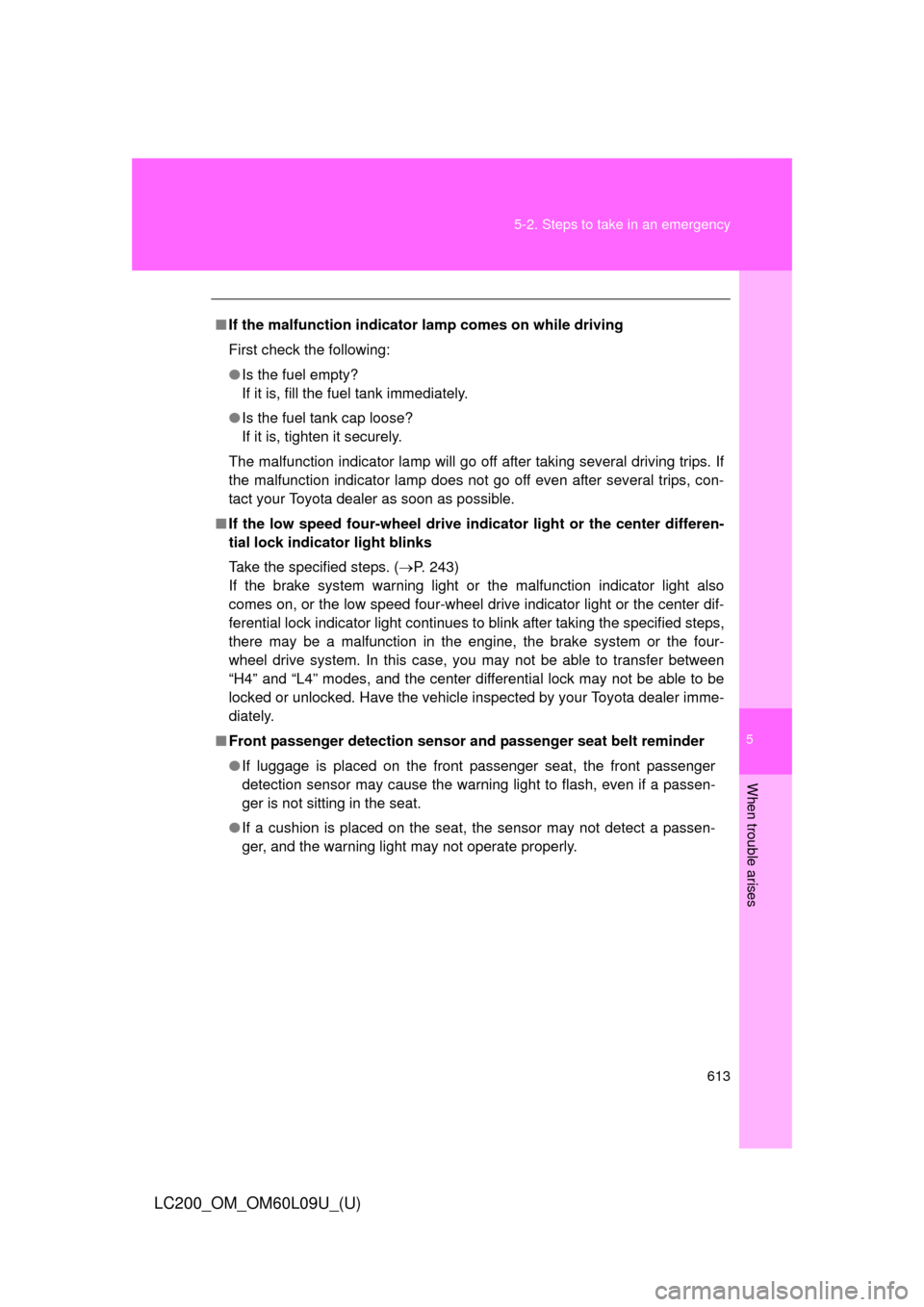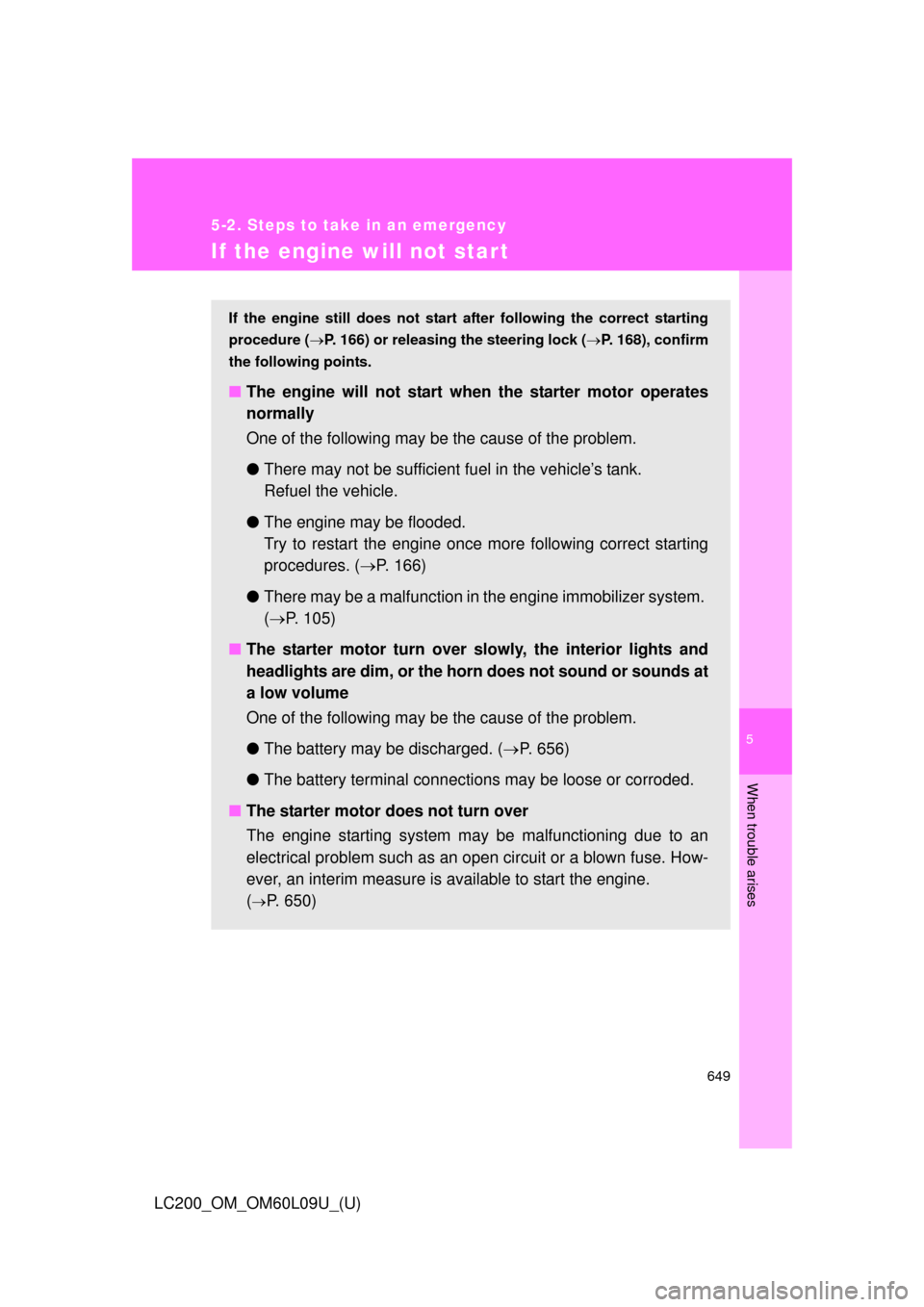Page 613 of 724

5
When trouble arises
613
5-2. Steps to take in an emergency
LC200_OM_OM60L09U_(U)
■
If the malfunction indicator lamp comes on while driving
First check the following:
● Is the fuel empty?
If it is, fill the fuel tank immediately.
● Is the fuel tank cap loose?
If it is, tighten it securely.
The malfunction indicator lamp will go off after taking several driving trips. If
the malfunction indicator lamp does not go off even after several trips, con-
tact your Toyota dealer as soon as possible.
■ If the low speed four-wheel drive in dicator light or the center differen-
tial lock indicator light blinks
Take the specified steps. ( P. 243)
If the brake system warning light or the malfunction indicator light also
comes on, or the low speed four-wheel drive indicator light or the center dif-
ferential lock indicator light continues to blink after taking the specified steps,
there may be a malfunction in the engine, the brake system or the four-
wheel drive system. In this case, you may not be able to transfer between
“H4” and “L4” modes, and the center differential lock may not be able to be
locked or unlocked. Have the vehicle inspected by your Toyota dealer imme-
diately.
■ Front passenger detection sensor and passenger seat belt reminder
● If luggage is placed on the front passenger seat, the front passenger
detection sensor may cause the warning light to flash, even if a passen-
ger is not sitting in the seat.
● If a cushion is placed on the seat, the sensor may not detect a passen-
ger, and the warning light may not operate properly.
Page 617 of 724

5
When trouble arises
617
5-2. Steps to take in an emergency
LC200_OM_OM60L09U_(U)
CAUTION
■Maintenance of the tires
Each tire, including the spare (if provided), should be checked monthly
when cold and inflated to the inflation pressure recommended by the
vehicle manufacturer on the vehicle
placard or tire inflation pressure
label (tire and load information label). (If your vehicle has tires of a differ-
ent size than the size indicated on the vehicle placard or tire inflation
pressure label [tire and load information label], you should determine the
proper tire inflation pr essure for those tires.)
As an added safety feature, your vehicle has been equipped with a tire
pressure monitoring system (TPMS-ti re pressure warning system) that
illuminates a low tire pressure telltal e (tire pressure warning light) when
one or more of your tires is significantly under-inflated. Accordingly,
when the low tire pressure telltale (tire pre ssure warning light) illumi-
nates, you should stop and check your tires as soon as possible, and
inflate them to the proper pressure. Driving on a significantly under-
inflated tire causes the tire to overheat and can lead to tire failure.
Under-inflation also reduces fuel effi ciency and tire tread life, and may
affect the vehicle’s handling and stopping ability.
Please note that the TPMS (tire pressure warning system) is not a sub-
stitute for proper tire ma intenance, and it is the driver’s responsibility to
maintain correct tire pressure, even if under-inflation has not reached the
level to trigger illu mination of the TPMS low ti re pressure telltale (tire
pressure warning light).
Page 626 of 724
626 5-2. Steps to take in an emergency
LC200_OM_OM60L09U_(U)
Warning messageDetailsCorrection procedure
(Flashes)
(If equipped) Indicates that the pre-
collision system is not
currently functional
because the grille or
the sensor is dirty
• Check the grille and the
sensor and clean them
if they are dirty.
• In case of overheating, the system will become
functional once the sys-
tem cools down.
Indicates that the pre-
collision system is not
currently functional
due to overheating.
Indicates that intui-
tive parking assist is
dirty or covered with
ice
Clean the sensor.
Indicates that remain-
ing fuel is about 4.0
gal. (15.0 L, 3.3 Imp.
gal.) or less Refuel the vehicle.
Page 649 of 724

5
When trouble arises
649
5-2. Steps to take in an emergency
LC200_OM_OM60L09U_(U)
If the engine will not star t
If the engine still does not start after following the correct starting
procedure ( P. 166) or releasing the steering lock (P. 168), confirm
the following points.
■ The engine will not start when the starter motor operates
normally
One of the following may be the cause of the problem.
●There may not be sufficient fuel in the vehicle’s tank.
Refuel the vehicle.
● The engine may be flooded.
Try to restart the engine once more following correct starting
procedures. ( P. 166)
● There may be a malfunction in the engine immobilizer system.
( P. 105)
■ The starter motor turn over slowly, the interior lights and
headlights are dim, or the horn does not sound or sounds at
a low volume
One of the following may be the cause of the problem.
●The battery may be discharged. ( P. 656)
● The battery terminal connec tions may be loose or corroded.
■ The starter motor does not turn over
The engine starting system may be malfunctioning due to an
electrical problem such as an open circuit or a blown fuse. How-
ever, an interim measure is available to start the engine.
(
P. 650)
Page 667 of 724
Vehicle specifications6
667
LC200_OM_OM60L09U_(U)
6-1. SpecificationsMaintenance data (fuel, oil level, etc.) ......... 668
Fuel information ............... 678
Tire information ................ 682
6-2. Customization Customizable features ..... 694
6-3. Initialization Items to initialize .............. 703
Page 668 of 724
668
LC200_OM_OM60L09U_(U)
6-1. Specifications
Maintenance data (fuel, oil level, etc.)
Dimensions and weights
*1: Unladen vehicle
*2: Vehicles without roof rail and cross bar
*3: Vehicles with roof rail and cross bar
Overall length196.5 in. (4990 mm)
Overall width77.6 in. (1970 mm)
Overall height*174.0 in. (1880 mm)*2
76.2 in. (1935 mm)*3
Wheelbase112.2 in. (2850 mm)
TreadFront64.6 in. (1640 mm)
Rear64.4 in. (1635 mm)
Vehicle capacity weight
(Occupants + luggage)1295 lb. (585 kg)
TWR (trailer weight
+ cargo weight)With brake8100 lb. (3670 kg)
Without brake1000 lb. (454 kg)
Page 670 of 724
670 6-1. Specifications
LC200_OM_OM60L09U_(U)
Engine
Fuel
Model5.7L V8 (3UR-FE)
Ty p e8-cylinder V type, 4-cycle, gasoline
Bore and stroke3.70 4.02 in. (94.0 102.0 mm)
Displacement345.6 cu.in. (5663 cm3)
Valve clearanceAutomatic adjustmentDrive belt tension
Fuel typeUnleaded gasoline only
Octane rating87 (Research octane number 91) or higher
Fuel tank capacity
(Reference)24.5 gal. (93 L, 20.4 Imp.gal)
Page 671 of 724
671
6-1. Specifications
6
Vehicle specifications
LC200_OM_OM60L09U_(U)
Lubrication system
*: The engine oil capacity is a reference quantity to be used when changing the
engine oil. Warm up and turn off the engine, wait more than 5 minutes, and
check the oil level on the dipstick.
■ Engine oil selection
“Toyota Genuine Motor Oil” is used in your Toyota vehicle. Use
Toyota approved “Toyota Genuine Motor Oil” or equivalent to satisfy
the following grade and viscosity.
Oil grade: ILSAC GF-5 multigrade engine oil
Recommended viscosity: SAE 0W-20
SAE 0W-20 is the best choice for
good fuel economy and good
starting in cold weather.
If SAE 0W-20 is not available,
SAE 5W-20 oil may be used.
However, it must be replaced
with SAE 0W-20 at the next oil
change.
Oil capacity
(Drain and refill — reference
*)
With filter
Without filter7.9 qt. (7.5 L, 6.6 Imp.qt.)
7.5 qt. (7.1 L, 6.2 Imp.qt.)
Outside temperature